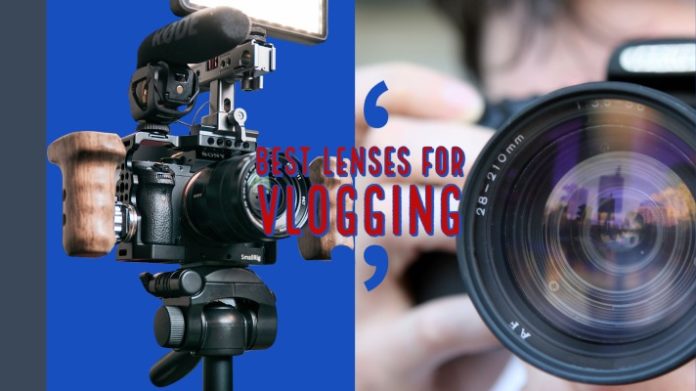Vlogging has gained great prominence in the last few years. It is the practice of posting short videos to a vlog or to maintain a vlog. You may wonder what a vlog is. It stands for a video blog, and in such blogs, most or every type of content is available in a video format. Generally, vlog posts comprise creating a video where you discuss a specific subject. If you intend to begin vlogging but inexperienced in this industry, you may be perplexed on what lens to use.
Related: List of the Best Interview Microphones
Worry not! It can seem not easy initially, but this post is solely created to give you enough information to get you started.
The present post provides thorough details on all the procedures of selecting the appropriate lens. After you know how to choose, you will be guided on those decent enough models for vloggers.
If you plan to start vlogging on YouTube or want to buy a mirrorless camera or DSLR camera, you can pick the lens from this list. This is regardless of the camera brand.
Now let’s learn what to emphasize first.
Also Read: List of Budget Cameras with Flip Screens
What Lens Will I Need?
Firstly, you need to be familiar with the sensor size of the camera you plan to use. It can be any one of the following:
- Full-frame
- APS-C
- Micro Four Thirds
The majority of the DSLRs possess an APS-C sensor, whereas the full-frame is present only in the most high-end DSLRs in the market.
The full-frame is the biggest size and provides supreme benefits when it comes to image quality.
Contrasting to that, the Micro Four Thirds sensors are the tiniest of these 3 types. Frequently, they are found in a few mirrorless camera brands such as Olympus and Panasonic. Yet, APS-C is prevalent in Sony mirrorless cameras.
It is vital to know your camera’s sensor size to make sure you can pick up the appropriate focal length.
Selecting the Perfect Focal Length:
A lens equipped with a focal length of 50 mm will appear more zoomed-in while utilized on a Micro Four Thirds camera than on an APS-C.
With a focal length of 50 mm, the lens would appear more zoomed-in while incorporated on an APS-C camera than on a Full-frame.
It is crucial first to select the perfect length. The reason is it informs you of the zoom level your camera can attain.
I wish to demonstrate how various focal lengths appear by depicting you a few example images of lenses with focal lengths like 50 mm, 35 mm, and 24 mm. These 3 focal lengths are the prominent choices for vlogging.
Every image I am about to depict you were captured in an APS-C sensor camera. Hence, if your camera makes use of any other size, go through the below table to determine which focal length would be the best fit to attain a similar look:
Focal Length Equivalency Table:
| Full-frame | APS-C | Micro 4/3 |
| 80 mm | 50 mm | 38 mm |
| 56 mm | 35 mm | 27 mm |
| 38 mm | 24 mm | 18 mm |
To select the appropriate focal length, it is necessary to know how you intend to use your camera.
Focal Lengths as given are nearly comparable and may designate available lenses:
| Film Size | 35mm | 120 | 2″x3″ | 4″x5.” |
|---|---|---|---|---|
| Image Format | 24x36mm | 56x68mm | 2″x3″ | 4″x5.” |
| Film Type | roll | roll | sheet | sheet |
| Fisheye | ||||
| Focal Length | 18mm | 37mm | —- | —- |
| Ex. Wide Angle | ||||
| Focal Length | 20mm | —- | 65mm | |
| 24mm | 50mm | 47mm | —- | |
| 28mm | 65mm | 53mm | 90mm (3-1/2″) | |
| Moderate Wide Angle | ||||
| Focal Length | 100mm (4″) | |||
| 35mm | 75mm | 65mm | 127mm (5″) | |
| 40mm | 75mm | 135mm (5-1/4″) | ||
| Normal | ||||
| Focal Length | 50mm | 110mm | 100mm | 152mm (6″) |
| 65mm | 127mm | —- | 203mm (8″) | |
| Moderate Telephoto | ||||
| Focal Length | 85mm | 150mm | —- | 250mm (10″) |
| 270mm | ||||
| Medium Telephoto | ||||
| Focal Length | 100mm | 210mm | 202mm | —- |
| 135mm | 250mm | —- | 380mm (15″) | |
| Long Telephoto | ||||
| Focal Length | 250mm | 500mm | —- | —- |
| 500mm | —- | —- | —- | |
When shall I use a 50mm lens??
For recording at home and plenty of space available in the studio, you can go for a 50 mm lens as it boasts the highest quality output.
For effective use, you will require a tripod. This is because the lens comes with a considerable zoom effect.
Also, you will require ample space and a remote controller to position the camera at enough distance away.
When using on an APS-C camera, the 50 mm lens appears like this:
If you dislike the zoom effect, you can go for a 35 mm lens.
It depicts more portion of the surroundings. Moreover, it is helpful to show more portions f the space you are currently at.
Since you may not have to place your camera at a far distance, you don’t require much space.
It appears like this:
When shall I use a wide-angle lens (focal length of 24mm or less)?
Using a camera in selfie mode and recording videos while walking will require a wide-angle lens. This type of lens lets you stay near to your camera.
For APS-C, I recommend choosing a focal length not more than 24mm.
In case you utilize a selfie stick to carry along your camera when recording on your own, it must look this below:
It is possible to use wider lenses. However, keep in mind that occasionally the things begin to appear distorted, identical to a fish-eye lens.
It is advisable to make use of a selfie stick. You can use any of these tiny tripods along with your camera. This is since it assures high stabilization and makes sure the camera stays far from your face.
Is Optical Image Stabilization (OIS) Needed?
I never recommend a camera that lacks an image stabilization (IS) feature. It is inevitable for vloggers.
To make sure I am telling the truth, watch the below video test that demonstrates with and without OIS function on GoPro HERO5 Black:
Nobody likes the shaky effect after watching you when you walk around carrying your camera.
But, plenty of mirrorless and DSLRs cameras I recommend over this website are devoid of image stabilization. However, it is because you can purchase a lens with OIS for them.
You may not need it every time.
For example:
For the following cases, you don’t require the OIS feature:
- You intend to place your camera on a tripod and use it merely for recording, or
- You want to walk around carrying your camera when recording; however, your camera is already equipped with in-body IS (digital IS not considered)
You need the OIS feature for the following cases:
- You have to walk around carrying your camera when recording (handheld)
- Your camera only possess digital image stabilization
If you have to hold your camera, the OIS feature is necessary.
Those lenses with OIS are usually costly, so pick it only if you actually require it.
Now ask yourself about your budget for buying the lens.
For that, you have to:
Get Familiar About Aperture and f-Number:
The f-number is one of the significant characteristics found in such lenses.
It appears like f/1.4, f/1.8, f/2.0…
The above is merely a measure to demonstrate the maximum aperture the lens can handle.
- More lens aperture is proportional to more light the lens enables to penetrate the sensor.
- More lens aperture is proportional to higher quality
- More lens aperture is proportional to the lower f-number
Remember:
The lens can receive more light if the f-number is lower—the same converts to enhanced low-light performance.
The depth of field is directly proportional to the f-number. It results in the production of a huge portion of the blurry background effect.
The lens can achieve a better quality output if the f-number is lower. It provides a better Bokeh effect, sharper images, and more light.
If the focal length is bigger, the lenses would have more aperture and a lower f-number. So, you must begin by asking if you can use a 50 mm. If this lens provides an excessive zoom effect, select a wide-angle lens with a low aperture, such as 24 mm.
Always target to get the lens with the lowest f-number possible.
Avoid Choosing an Incompatible Lens:
The eventual aspect you have to know is the type of lens mount your camera possesses.
Though the lens is designed for your explicit brand and the sensor size, you must know about the mount.
For instance, all APS-C Canon lenses are not compatible with all the Canon APS-C cameras. Make sure if your camera utilizes EF, EF-S, or the EF-M mount.
If this sounds too complex, worry not.
I am ascertaining that I am incorporating all the mounts and the information you have to know to check if a lens is compatible with the camera you use.
It is great to go through your camera manual or product detail available on an e-commerce site. As a result, you can determine the mount-type and sensor size your camera possesses.
Now You Are Aware of How to Choose
You have now learned to consider the following things:
- Determine the sensor size of your camera
- Determine the focal length you require for your specific vlogging style
- Determine if you require optical image stabilization
- Determine the lens mount of your camera, so you don’t end up with an incompatible lens
- Pick the lens having the lowest f-number that you could afford for attaining the superior quality output.
With this information, now you can go through the table I prepared for your brand. So, you can pick one of the vlogging lenses I have chosen to be appropriate for vlogging.
Let’s go through the details of the best lenses for vlogging:
- The 51 Best Lenses for Vlogging
- Canon Vlogging Lenses
- Zoom Lenses
50mm:
These lenses provide plenty of zoom effects. I advise using a tripod for recording with these lenses. This is because you will have to get far from the camera to be within the frame. The same applies to Full-frame cameras.
| Parameters | Canon EF 50mm f/1.8 STM Lens | Canon EF 40mm f/2.8 STM Lens | Canon EF 50mm f/1.4 USM | Sigma 50mm F1.4 ART DG HSM | Canon EF 50mm f/1.2 L USM Lens |
| Image | 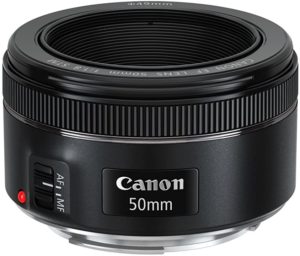 | 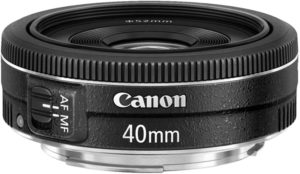 | 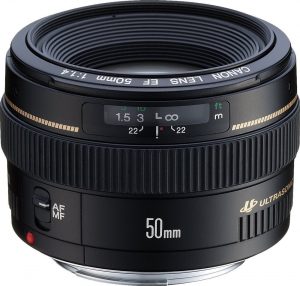 | 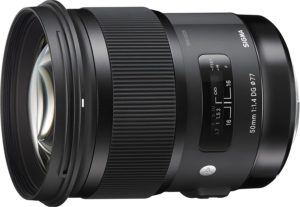 | 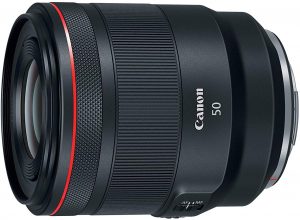 |
| Brand | Canon | Canon | Canon | Sigma | Canon |
| Lens Type | Standard | Standard | Telephoto | Standard | Standard |
| Focal length | 50 mm | 40 mm | 50 mm | 50 mm | 50 mm |
| OIS | Not available | Not available | Not available | Not available | Not available |
| Motor operation | EF STM (Stepping motor) | EF STM (Stepper motor) | EF USM (Ultrasonic autofocus motor) | DG HSM (Hyper Sonic Motor) | EF USM (Ultrasonic Motor) |
| Maximum Aperture | f/1.8 | f/2.8 | f/1.4 | f/1.4 | f/1.2 |
| Minimum Aperture | 22 | 22 | 22 | 16 | 16 |
| Focus type | Stepper motor | Stepper motor | Ultrasonic | Ring-type ultrasonic | Ring-type ultrasonic |
| Camera Compatibility | Full-frame, APS-C, Mirrorless (with adapter) | Full-frame, APS-C, Mirrorless (with adapter) | Full-frame, APS-C, Mirrorless (with adapter) | Full-frame, APS-C | Full-frame, APS-C, Mirrorless (with adapter) |
| Photo Filter Thread size | 49 mm | 52 mm | 58 mm | 77 mm | 72 mm |
| Lens construction | 6 elements in 5 groups | 15 Elements in 12 Groups | 7 elements in 6 groups | 13 elements in 8 groups | – |
| Closest Focusing Distance | 1.15 ft. / 0.35m | 0.98 ft./0.30 m | 1.5 feet | 1.31 ft./0.4m | 1.48 ft. /0.45m |
| Product dimensions | 1.54 x 2.72 x 2.72 inches | 0.87 x 2.68 x 2.68 inches | 2.01 x 2.91 x 2.91 inches | 3.94 x 3.35 x 3.35 inches | 2.6 x 3.39 x 3.39 inches |
| Weight | 5.60 ounces | 4.59 ounces | 0.64 lbs | 1.80 lbs | 1.28 lbs |
| Buy Now | Check on Amazon | Check on Amazon | Check on Amazon | Check on Amazon | Check on Amazon |
35mm:
These lenses are suitable for recording yourself in the selfie mode when you use a Full-frame. When using APS-C cameras, you need to remember to use these lenses for tripod recording and not a 50 mm lens. This needs to be considered if you deem that the zoom is excessive.
| Parameters | Canon EF-S 35mm f/2.8 Macro IS STM | Sigma 30mm F1.4 Art DC HSM | Canon EF 28mm f/1.8 USM | Canon EF 35mm f/2 IS USM | Canon EF 35mm f/1.4L USM |
| Image | 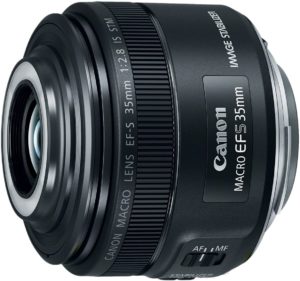 | 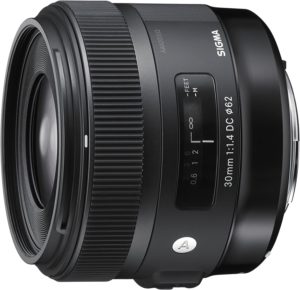 | 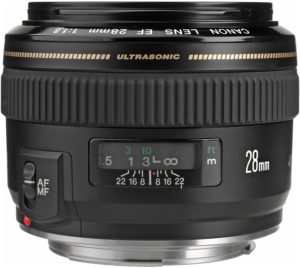 |  | 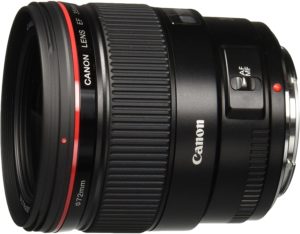 |
| Brand | Canon | Sigma | Canon | Canon | Canon |
| Lens Type | Macro | Standard | Wide Angle | Wide Angle | Wide Angle |
| Focal length | 35 mm | 30 mm | 28 mm | 35 mm | 35 mm |
| OIS | Available | Not available | Not available | Available | Not available |
| Motor operation | EF-S STM (Stepper motor) | DC HSM (Hyper Sonic Motor) | EF USM (Ultrasonic Motor) | EF USM (Ultrasonic Motor) | EF USM (Ultrasonic Motor) |
| Maximum Aperture | f/2.8 | f/1.4 | f/1.8 | f/2 | f/1.4 |
| Minimum Aperture | 2.8 | 16 | 22 | 22 | 22 |
| Focus type | Autofocus | Ultrasonic | Ultrasonic | Ring-type ultrasonic | Ring-type ultrasonic |
| Camera Compatibility | APS-C, Mirrorless (with adapter) | Full-frame, APS-C | Full-frame, APS-C, Mirrorless (with adapter) | Full-frame, APS-C, Mirrorless (with adapter) | Full-frame, APS-C, Mirrorless (with adapter) |
| Photo Filter Thread size | – | 62 mm | 28 mm | 67 mm | 72 mm |
| Lens construction | – | – | 5 elements in 5 groups | 10 elements in 8 groups | 11 elements in 9 groups |
| Angle of view | 35mm standard angle of view | equivalent to 45mm on a 35mm camera | 75° | 63° | 63° |
| Closest Focusing Distance | 1.15 ft. / 0.35m | 0.98 ft./0.30 m | 1 foot | 0.79 ft. / 0.24m | 1 foot |
| Product dimensions | 2.2 x 2.7 x 2.7 inches | 2.48 x 2.91 x 2.91 inches | 2.2 x 2.91 x 2.91 inches | 2.48 x 3.07 x 3.07 inches | 3.39 x 3.11 x 3.11 inches |
| Weight | 6.70 ounces | 0.96 lbs | 0.68 lbs | 0.74 lbs | 1.28 lbs |
| Buy Now | Check on Amazon | Check on Amazon | Check on Amazon | Check on Amazon | Check on Amazon |
Wide-angle for Handheld Vlogging
The wide-angle lenses are designed for recording in the selfie mode on Full-frame as well as APS-C cameras. Such lenses attain a wide image when utilizing the latter.
| Parameters | Canon EF-S 24mm f/2.8 STM Lens | Canon EF-S 10-18mm f/4.5-5.6 IS STM Lens | Sigma 10-20mm f/3.5 DC HSM Lens | Canon EF 20mm f/2.8 USM Lens | Canon EF 24mm f/2.8 IS USM Lens |
| Image | 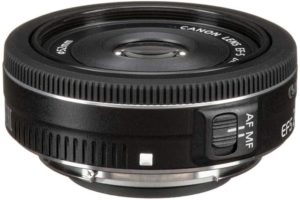 | 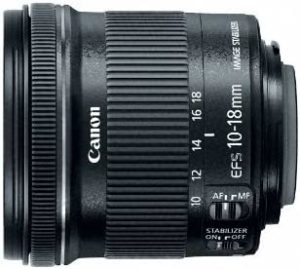 | 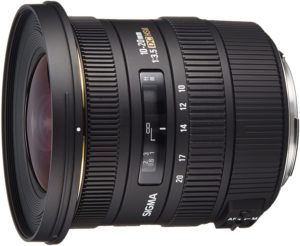 | 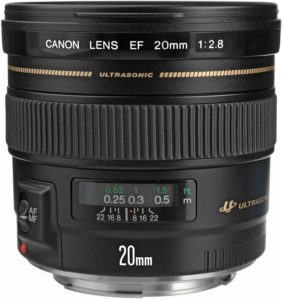 | 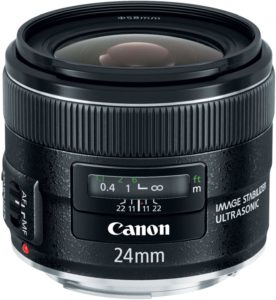 |
| Brand | Canon | Canon | Sigma | Canon | Canon |
| Lens Type | Wide Angle | Wide Angle | Wide Angle | Wide Angle | Wide Angle |
| Focal length | 24 mm | 10-18 mm | 10-20 mm | 20 mm | 24 mm |
| OIS | Not Available | Available | Not available | Not Available | Available |
| Motor operation | EF-S STM (Stepper motor) | EF-S (Stepping motor) | EX DC HSM (Hyper Sonic Motor) | EF USM (Ultrasonic motor) | EF USM (Ultrasonic motor) |
| Maximum Aperture | f/2.8 | f/4.5 | f/3.5 | f/2.8 | f/2.8 |
| Minimum Aperture | 22 | 29 | 22 | 22 | 22 |
| Focus type | Stepper motor | Stepper motor | Ring-type ultrasonic | Ultrasonic | Ring-type ultrasonic |
| Camera Compatibility | APS-C / Mirrorless (with adapter) | APS-C / Mirrorless (with adapter) | APS-C | Full-frame, APS-C, Mirrorless (with adapter) | Full-frame, APS-C, Mirrorless (with adapter) |
| Photo Filter Thread size | 52 mm | 67 mm | 82 mm | 72 mm | 58 mm |
| Lens construction | 6 elements in 5 groups | 14 elements in 11 groups | – | 11 elements in 9 groups | 11 elements in 9 groups |
| Angle of view | 59°10′ | 107°30′ – 74°20′ | 102.4° | 94° | 84° |
| Closest Focusing Distance | 0.52 ft. / 0.16 m | 0.72 ft. / 0.22m | 0.78 ft./0.24m | 0.8 ft. / 0.24m | 0.20m / 0.66 ft. |
| Product dimensions | 0.91 x 2.68 x 2.68 inches | 2.83 x 2.95 x 2.95 inches | 3.46 x 3.43 x 3.43 inches | 2.8 x 3.07 x 3.07 inches | 2.2 x 2.68 x 2.68 inches |
| Weight | 4.41 ounces | 0.53 lbs | 1.15 lbs | 0.89 lbs | 0.62 lbs |
| Buy Now | Check on Amazon | Check on Amazon | Check on Amazon | Check on Amazon | Check on Amazon |
EF-M Lenses for Canon Mirrorless:
Such lenses are flawlessly compatible with Canon’s EF-M cameras, and they are their mirrorless APS-C cameras. Moreover, these lenses are excellent for vlogging. They are famous for being lightweight, and the majority of them possess image stabilization.
| Parameters | Canon EF-M 22mm f2 STM | Canon EF-M 28mm f/3.5 Macro IS STM Lens | Canon EF-M 11-22mm f/4-5.6 STM Lens |
| Image | 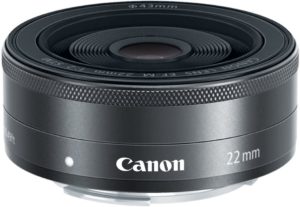 | 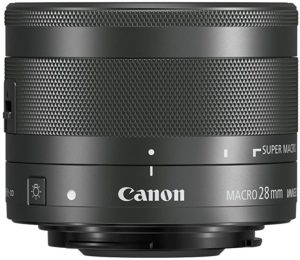 | 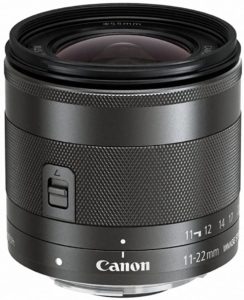 |
| Brand | Canon | Canon | Canon |
| Lens Type | Standard | Macro | Wide Angle |
| Focal length | 22 mm | 28 mm | 11-22 mm |
| OIS | Not Available | Available | Available |
| Motor operation | EF-M STM (Stepper motor) | EF-M STM (Stepper motor) | EF-M STM (Stepper motor) |
| Maximum Aperture | f/2.0 | f/3.5 | f/4 |
| Minimum Aperture | 22 | – | 22 |
| Focus type | Stepper motor | – | Autofocus |
| Camera Compatibility | Mirrorless | Mirrorless | Mirrorless |
| Photo Filter Thread size | 43 mm | – | 55 mm |
| Lens construction | 7 elements in 6 groups | 11 elements in 10 groups | 12 elements in 9 groups |
| Angle of view | 63°30′ | 51°55’ | 102°10’–63°30′ |
| Closest Focusing Distance | 0.49 ft./ 0.15m | 0.318 ft./0.097m | 0.49 ft./0.15m |
| Product dimensions | 0.94 x 2.4 x 2.4 inches | 3.7 x 3.7 x 4.5 inches | 3.7 x 3.7 x 6.08 inches |
| Weight | 3.70 ounces | 4.6 ounces | 7.76 ounces |
| Buy Now | Check on Amazon | Check on Amazon | Check on Amazon |
Types of Canon Lenses:
EF:
These types of Canon lenses are designed to use with their full-frame cameras. But, they can also work with APS-C.
Also, you can use them on an EF-M mirrorless through this adapter.
EF-S:
The EF-S lenses are compatible only with APS-C sensors. For use on a Canon mirrorless camera that contains an EF-M mount, you need this adapter.
EF-M:
Such lenses were designed for Canon mirrorless cameras.
Sigma’s DC:
They are compatible with APS-C cameras.
STM (Smooth Transition for Motion):
These types of lenses include a motor that is designed to work silently while focusing. The same makes them suitable for recording. This is since you would not listen to the autofocus while the video is being played. It aids when you also use the incorporated microphone.
Especially, they are silent for video, which is one reason why Canon is more suitable for video.
USM (UltraSonic Motors):
The USM lenses focus more quickly, and they work silently. This holds only for those cameras that contain a Ring USM motor. Those lenses that are only of USM type are not so different from a standard one.
Only the costly models have Ring USM. Therefore, you must prioritize STM lenses because, for video recording, they are more silent.
Sigma’s HSM:
This is comparable to Canon’s USM lenses. Moreover, they are designed for quick and noise-free focus.
IS (Image Stabilization):
Several DSLR cameras are devoid of image stabilization. This is the key aspect you must focus on if you want to record during movements. Plenty of vloggers want to carry their cameras and accomplish recording while walking. Such lenses are ideal for this since the image will not appear unsteady while you walk and record.
Nikon Vlogging Lenses:
Nikon zoom lenses suitable for use on a tripod:
| Parameters | Nikon AF FX NIKKOR 50mm f/1.8D Lens | Nikon 35mm f/1.8G AF-S DX Lens | Nikon AF-S FX NIKKOR 50mm f/1.8G Lens | Nikon AF-S FX NIKKOR 50mm f/1.4G Lens | Sigma 30mm F1.4 Art DC HSM Lens for Nikon |
| Image | 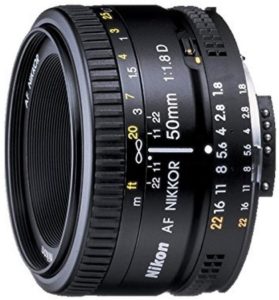 | 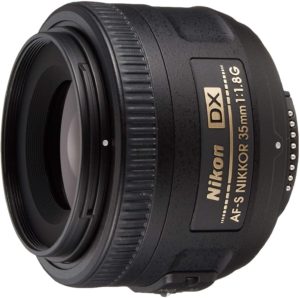 | 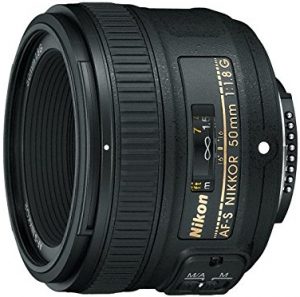 | 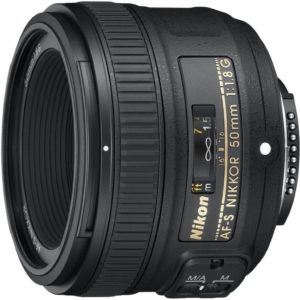 | 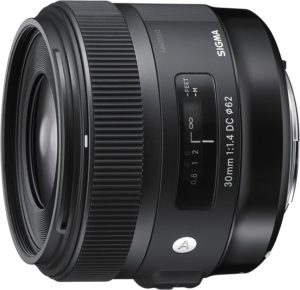 |
| Brand | Canon | Canon | Sigma | Canon | Canon |
| Lens Type | Standard | Wide Angle | Standard | Standard | Standard |
| Focal length | 50 mm | 35 mm | 50 mm | 50 mm | 30 mm |
| OIS | Not Available | Not Available | Not available | Not Available | Not Available |
| Type | AF FX | AF-S DX | AF-S FX | AF-S FX | DC HSM |
| Motor operation | Silent Wave Motor (SWM) | Silent Wave Motor (SWM) | Silent Wave Motor (SWM) | Silent Wave Motor (SWM) | Hyper Sonic Motor (HSM) |
| Maximum Aperture | f/1.8 | f/1.8 | f/1.8 | f/1.4 | f/1.4 |
| Minimum Aperture | 22 | – | 16 | 16 | 16 |
| Focus type | Screw drive from the camera | – | Ultrasonic | Ring-type ultrasonic | Ultrasonic |
| Camera Compatibility | Full-frame, APS-C | APS-C | Full-frame, APS-C | Full-frame, APS-C | APS-C |
| Photo Filter Thread size | 52 mm | 52 mm | 58 mm | 58 mm | 62 mm |
| Angle of view | 31°30′ (DX-format)/ 46°(FX-format)/ | – | 47° | 31°30′ (DX format)/ 46°(FX format)/ | equivalent to 45mm on a 35mm camera |
| Closest Focusing Distance | 1.5 ft./ 0.45 m | – | 1.48 ft/ 0.45 m | 1.47 ft. / 0.45 m | 0.98 ft/ 0.3 m |
| Product dimensions | 2.5 x 2.5 x 1.54 inches | 2.09 x 2.76 x 2.76 inches | 2.09 x 2.83 x 2.83 inches | 2.13 x 2.91 x 2.13 inches | 2.48 x 2.91 x 2.91 inches |
| Weight | 5.47 ounces | 7.4 ounces | 6.53 ounces | 0.64 lbs | 0.96 lbs |
| Buy Now | Check on Amazon | Check on Amazon | Check on Amazon | Check on Amazon | Check on Amazon |
Wide-angle Lenses for Handheld Vlogging:
I came to know that Nikon does not provide any feasible wide-angle lens for vlogging. In case you only use a Nikon DSLR and wish to perform handheld vlogging, I will recommend Sigma 10-20mm f/3.5 EX DC HSM (check it here).
The reason is it is the only lens available at a slightly affordable price. However, it does not come with image stabilization.
Nikon cameras were not designed for portable video recording. Thus, if you need a camera for recording vlogs regardless of the place, choose a compact camera (check it here), and use your Nikon DSLR for recording videos through a tripod when incorporating any of the lenses discussed above.
Using 2 distinct cameras for every task is the only approach if you use a Nikon camera.
Types of Nikon Lenses:
DX:
These Nikon’s lenses are designed for APS-C. It is possible to use them on Full-frame (FX) lenses as well. However, to prevent hassles with vignetting, go for a DX lens when using a DX camera.
FX:
Such lenses are designed for the Full-frame cameras from Nikon. But you could use them on the DX bodies; no worries.
AF (Autofocus):
These types of lenses are the most affordable. They implement the body motor of the camera to autofocus. In case a motor is absent, they could not use autofocus. It implies that the performance of your lenses relies on the motor performance of the camera.
AF-S (Auto Focus with Silent Wave Moto):
There is an internal motor for the lens to implement instead of using the one that ships along with the body. Generally, they contain an efficient motor for quick and quiet autofocus rather than what the camera provides. So, you will get them at a high price.
D Type:
These lenses are an earlier model from the brand Nikon. The key difference is that you could manually set the aperture using the lens instead of using the camera interface. It is now futile, so only a type of lens is vanishing.
G Type:
Considered the latest NIKKOR lenses, they are devoid of the manual aperture setting. Still, you can use the interface of the camera. Essentially, they are more costly because they are newer models. But there is no prominent difference.
You need not worry about D vs. G comparison while selecting a Nikon lens. It would help if you considered AF vs. AF-S.
For Sigma lenses nomenclature, choose the 50mm Fixed Lenses for following the Sigma DSLR section.
Sony Vlogging Lenses:
If you are planning to invest in the Sony mirrorless ecosystem, our recommendations should meet your expectations when it comes to vlogging.
Best Sony Full-frame Lenses:
The below lenses are slightly costly since you can use them on Full-frame cameras from Sony, for example, the Sony A7S II. But, you can also use them on Sony APS-C Mirrorless cameras.
Zoom lenses suitable for use on a tripod (Full-frame):
Keep in mind that the output of an 80mm lens over a Full-frame camera appears like a 50 mm lens in an APS-C camera. Therefore, a 35mm lens within a Full-frame camera is regarded as wide-angle; not suitable on an APS-C.
If you want, look at the table above to know the focal length parity for every sensor size.
| Parameters | Sony – FE 50mm F1.8 Standard Lens (SEL50F18F) | Sony 55mm F1.8 Sonnar T FE ZA Lens | Zeiss Batis 85mm f/1.8 Lens for Sony E Mount | Sony SEL50F14Z Planar T FE 50mm f/1.4 ZA Lens |
| Image | 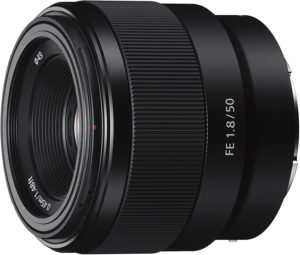 |  | 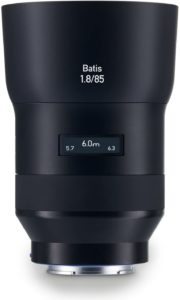 | 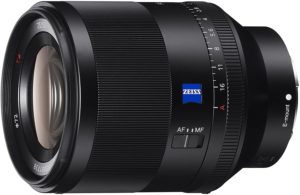 |
| Brand | Sony | Sony | Zeiss | Sony |
| Lens Type | Standard | Standard | Telephoto | Standard |
| Focal length | 50 mm | 55 mm | 85 mm | 50 mm |
| OIS | Not Available | Not Available | Not available | Not Available |
| Type | Full-frame E-mount (FE) | Full-frame E-mount (FE) | Full-frame E-mount (FE) | Full-frame E-mount (FE) |
| Motor operation | Fast DC motor focus actuator system | Stepper motor | – | Stepper motor |
| Maximum Aperture | f/1.8 | f/2.8 | f/1.8 | f/1.4 |
| Minimum Aperture | 22 | 22 | 22 | 16 |
| Focus type | Autofocus | Autofocus | Auto/Manual, Autofocus | Autofocus |
| Camera Compatibility | Full-frame, APS-C | Full-frame, APS-C | Full-frame, APS-C | Full-frame, APS-C |
| Photo Filter Thread size | 49 mm | 49 mm | 67 mm | – |
| Angle of view | 32° | 43° | – | – |
| Closest Focusing Distance | 1.48 ft. | 1.64 ft. | – | 1.48 ft |
| Product dimensions | 2.7 x 2.34 x 2.7 inches | 2.8 x 2.52 x 2.52 inches | 4.1 x 3.6 x 3.6 inches | 7.64 x 4.65 x 4.72 inches |
| Weight | 6.6 ounces | 9.9 ounces | 1.05 pounds | 2.41 pounds |
| Buy Now | Check on Amazon | Check on Amazon | Check on Amazon | Check on Amazon |
Wide-angle for handheld recording (Full-frame):
When you plan to record in selfie mode, you can go for a 35 mm, provided you use a Full-frame camera. When using APS-C, you require a lens with a minimum focal length of 24 mm. There is too a section after the below table.
| Parameters | Sony 35mm F2.8 Sonnar T FE ZA Lens | Zeiss Batis 25mm Wide-Angle Camera Lens | Sony 16-35mm Vario-Tessar T FE F4 ZA OSS Lens | Sony SEL35F14Z Distagon T FE 35mm ZA Lens |
| Image | 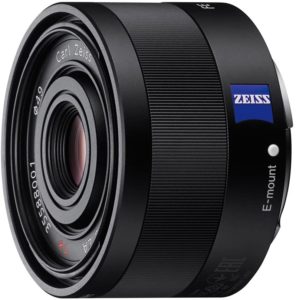 |  |  | 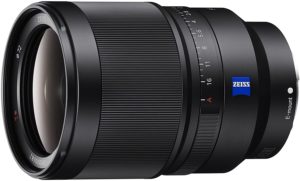 |
| Brand | Sony | Zeiss | Sony | Sony |
| Lens Type | Wide Angle | Wide Angle | Wide Angle | Wide Angle |
| Focal length | 35 mm | 25 mm | 16-35 mm | 35 mm |
| OIS | Not Available | Not Available | Available | Not Available |
| Type | Full-frame E-mount (FE) | – | Full-frame E-mount (FE) | Full-frame E-mount (FE) |
| Maximum Aperture | f/2.8 | f/2 | f/4 | f/1.4 |
| Minimum Aperture | 22 | 22 | 22 | 16 |
| Focus type | Internal focusing | Auto/Manual, Autofocus | Autofocus | Piezoelectric |
| Camera Compatibility | Full-frame, APS-C | Full-frame, APS-C | Full-frame, APS-C | Full-frame, APS-C |
| Photo Filter Thread size | 49 mm | 67 mm | 72 mm | 72 mm |
| Angle of view | 44º (APS-C), 63º (35 mm Full Frame) | – | 83°-44° (APS-C) 107°-63° (35mm) | – |
| Closest Focusing Distance | 1.15 ft./ 0.35 m | – | 0.92 ft/ 0.28 m | 0.98 ft/ 0.3 m |
| Maximum Magnification ratio | 0.12x | – | 0. 19x | 0.18x |
| Product dimensions | 1.46 x 2.44 x 2.44 inches | 3.6 x 3.2 x 3.2 inches | 3.9 x 3.07 x 3.07 inches | 4.41 x 3.11 x 3.11 inches |
| Weight | 4.23 ounces | 0.74 lbs | 1.14 lbs | 1.39 lbs |
| Buy Now | Check on Amazon | Check on Amazon | Check on Amazon | Check on Amazon |
Best Sony E-Mount Lenses (APS-C):
We did a post earlier for E-Mount, but the following list is purely focused on vlogging.
On a side note, even with image stabilization, Zoom lenses are suitable for use on a tripod (APS-C) in most scenarios.
| Parameters | Meike 35mm F1.7 Large Aperture Lens | Sigma 30mm F2.8 DN Lens | Sony – E 50mm F1.8 (SEL50F18/B) Lens | Rokinon 50mm F1.4 Lens | Sony SEL35F18 35mm f/1.8 Lens | ||
| Image | 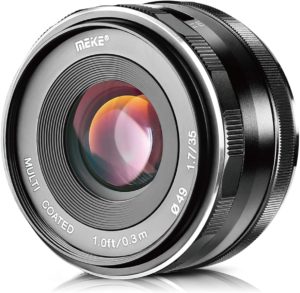 | 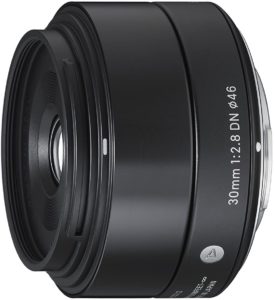 | 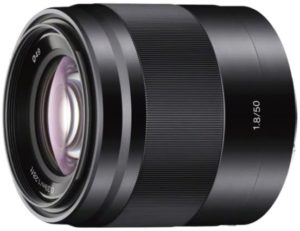 | 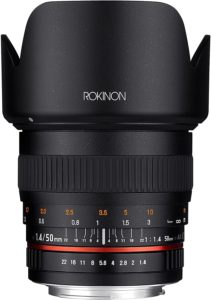 | 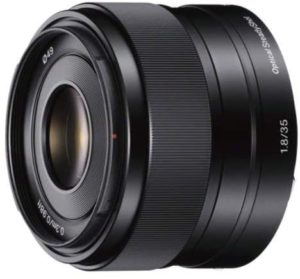 | ||
| Brand | Meike | Sigma | Sony | Rokinon | Sony | ||
| Lens Type | Prime lens | Wide Angle | Telephoto | Standard | Wide Angle | ||
| Focal length | 35 mm | 30 mm | 50 mm | 50 mm | 35 mm | ||
| OIS | Not Available | Not Available | Available | Not Available | Available | ||
| Type | E-Mount | E-Mount USM | E-Mount OSS | E-Mount | E-Mount | ||
| Maximum Aperture | f/1.7 |
| f/1.8 | f/1.4 | f/1.8 | ||
| Minimum Aperture | – | – | 22 | 22 | 22 | ||
| Focus type | Manual Focus | Manual Focus | Stepper motor | Manual Focus | Stepper motor | ||
| Sensor size | APS-C | APS-C | APS-C | APS-C | APS-C | ||
| Photo Filter Thread size | – | – | 49 mm | 77 mm | 49 mm | ||
| Angle of view | 44°20′ (Diagonal), 36°30′(Horizontal), 23° (Vertical) | 39.6° | 32° | – | 44° | ||
| Closest Focusing Distance | 0.98 ft./ 0.3 m | 0.98 ft./0.3 m | 1.28 ft./0.39 m) | 1.47 ft. / 0.45 m | 0.99 ft/ 0.3 m | ||
| Product dimensions | 1.8 x 1.8 x 1.23 inches | 2.4 x 60.6 x 1.4 inches | 2.44 x 2.44 x 2.44 inches | 3.97 x 3.2 x 3.2 inches | 1.77 x 2.48 x 2.48 inches | ||
| Weight | 6.40 ounces | 0 ounces | 7.13 ounces | 1.20 lbs | 5.47 ounces | ||
| Buy Now | Check on Amazon | Check on Amazon | Check on Amazon | Check on Amazon | Check on Amazon |
Wide-angle for handheld recording (APS-C)
| Parameters | Sony SELP1650 16-50mm Power Zoom Lens | Sony SEL-20F28 E-Mount 20mm F2.8 Lens | Sony SEL35F18 35mm f/1.8 Prime Fixed Lens | Sony F4 OSS Wide-Angle Zoom Lens (SEL1018) | Sony Carl Zeiss Sonnar T E 24mm F1.8 ZA Lens |
| Image | 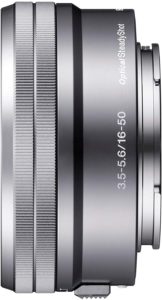 | 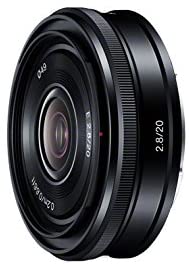 |  | 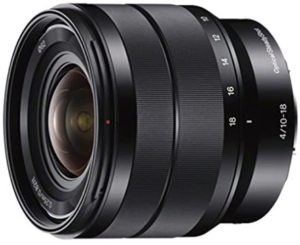 | 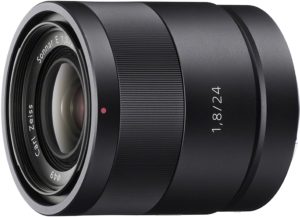 |
| Brand | Sony | Sony | Sony | Sony | Sony |
| Lens Type | Power Zoom lens | Wide Angle | Wide Angle | Wide Angle | Fisheye |
| Focal length | 16-50 mm | 20 mm | 35 mm | 10-18mm | 24 mm |
| OIS | Available | Not Available | Available | Available | Not Available |
| Type | E-Mount OSS | E-Mount | E-Mount OSS | E-Mount OSS | E-Mount |
| Motor operation | Internal Stepping Motor | Stepper motor | Stepper motor | Stepper motor | Stepper motor |
| Maximum Aperture | f/3.5 | f/2.8 | f/1.8 | f/4 | f/1.8 |
| Minimum Aperture | 36 | 22 | 22 | 22 | 22 |
| Focus type | Manual Focus | Stepper motor | Stepper motor | Stepper motor | Micromotor |
| Sensor size | APS-C | APS-C | APS-C | APS-C | APS-C |
| Photo Filter Thread size | – | 49 mm | 49 mm | 62 mm | 49 mm |
| Closest Focusing Distance | 0.25 m | 0.66 ft./0.2 m | 0.99 ft./0.3 m) | 0.82 ft. / 0.25 m | – |
| Product dimensions | 2.55 x 2.55 x 1.8 inches | 0.79 x 2.48 x 2.48 inches | 1.77 x 2.48 x 2.48 inches | 2.52 x 2.76 x 2.76 inches | 2.58 x 2.48 x 2.48 inches |
| Weight | 4.2 ounces | 2.43 ounces | 5.5 ounces | 7.9 ounces | 7.9 ounces |
| Buy Now | Check on Amazon | Check on Amazon | Check on Amazon | Check on Amazon | Check on Amazon |
SAM (Smooth Autofocus Motor):
This acronym is prevalent for the cost-effective but tad quiet and fast lenses from Sony. Recognized as the lower-end version of the SSM lenses, they are genuinely quick and silent.
DT (Digital Technology):
They are made for APS-C sensor cameras. Such cameras are the most reasonably priced mirrorless and DSLRs. Furthermore, they can be utilized on a full frame; however, they would crop the image.
OSS (Optical SteadyShot):
It is Optical Image Stabilization (OIS) from is Sony.
USM:
They belong to the lineup of Sigma (& Canon) silent autofocus lenses.
FE (Full-frame E-mount):
They work flawlessly with every E-mount camera, incorporating APS-C and Full-frame sensors.
E Mount/A Mount:
E-mount cameras could use A-mount lenses along with an adapter.
The A-mount cameras could not adopt E-mount lenses.
Panasonic and Olympus Vlogging Lenses:
The lenses discussed below are designed for Micro Four Thirds cameras. It is possible to use them on Panasonic or Olympus. Both of them implement this smaller sensor size for the corresponding camera and possess compatible lens mounts.
Remember that you have to purchase lenses with a low focal length for such cameras due to their crop factor. The resultant image on such sensors appears quite closer compared to that on APS-C.
Therefore, I have chosen lenses from a 27 mm focal length for tripod recording. On the other hand, 18 mm lenses are practical for handheld vlogging.
To compare how many focal lengths would appear on your video, you can glance at my focal length equivalency table.
Zoom Lenses for Tripod Recording:
| Parameters | Panasonic LUMIX G LENS, 25MM, F1.7 ASPH Lens | Sigma ART 30MM F2.8 DN Lens | Panasonic LUMIX G II LENS, 20MM, F1.7 ASPH | Olympus 25mm f1.8 Lens | Rokinon 35mm F1.4 AS UMC Lens |
| Image | 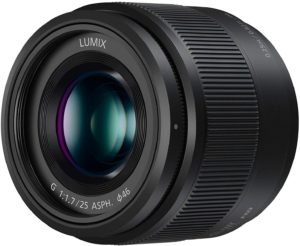 | 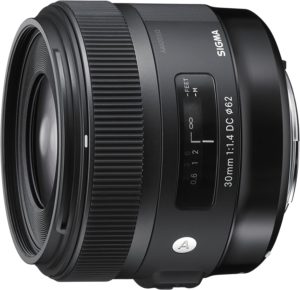 | 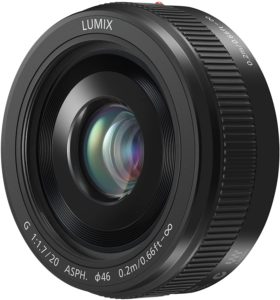 | 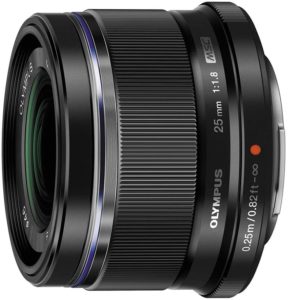 | 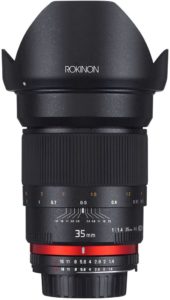 |
| Brand | Panasonic | Sigma | Panasonic | Olympus | Rokinon |
| Lens Type | Standard | Standard | Fisheye | Standard | Wide Angle |
| Focal length | 25 mm | 30 mm | 20 mm | 25 mm | 35 mm |
| OIS | Not Available | Not Available | Not Available | Not Available | Not Available |
| Autofocus | Available | Available | Available | Available | Not Available |
| Maximum Aperture | f/1.7 | f/2.8 | f/1.7 | f/1.8 | f/1.4 |
| Focus type | Manual Focus | Autofocus | Autofocus | Stepper motor | Manual focus |
| Sensor size | MFT | MFT | MFT | MFT | MFT |
| Photo Filter Thread size | – | – | 49 mm | 77 mm | 49 mm |
| Angle of view | 47° | the equivalent angle of view as a 60mm lens on the Micro Four Thirds systems | – | 47° | 84.1° (full-frame camera), 57.6° (APS-C) |
| Closest Focusing Distance | – | – | 0.66 ft./0.2 m) | – | 1 foot/ 0.3 m |
| Product dimensions | 3.23 x 3.23 x 4.41 inches | 2.4 x 60.6 x 1.4 inches | 1.02 x 2.48 x 2.48 inches | 1.61 x 2.2 x 2.2 inches | 4.6 x 3.3 x 3.3 inches |
| Weight | 4.41 ounces | 0 ounces | 3.07 ounces | 4.8 ounces | 1.4 pounds |
| Buy Now | Check on Amazon | Check on Amazon | Check on Amazon | Check on Amazon | Check on Amazon |
Wide-Angle for Handheld Recording:
| Parameters | Sigma 19mm F2.8 EX DN Art | Panasonic LUMIX G X Vario, H-PS14042S Lens | Olympus M.Zuiko f1.8 17mm Lens | Olympus M ED 9-18mm f/4.0-5.6 Lens | Olympus M. Zuiko Digital ED 12mm f/2.0 Lens |
| Image | 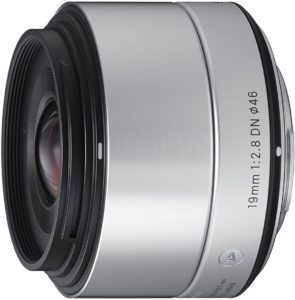 | 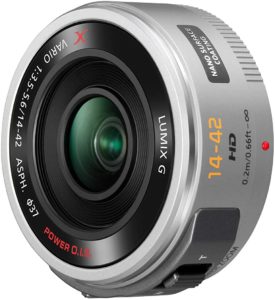 | 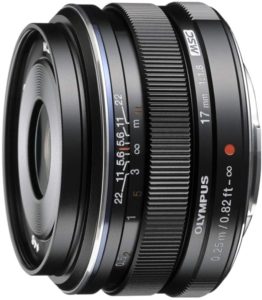 | 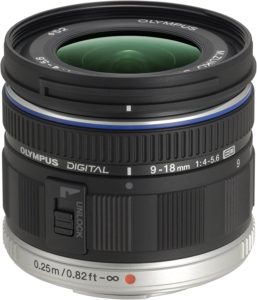 | 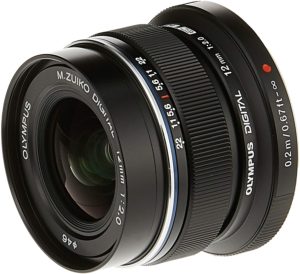 |
| Brand | Sigma | Panasonic | Olympus | Olympus | Olympus |
| Lens Type | Telephoto | Telephoto | Wide Angle | Wide Angle | Wide Angle |
| Focal length | 19 mm | 14-42 mm | 17 mm | 9-18 mm | 12 mm |
| OIS | Not Available | Available | Not Available | Not Available | Not Available |
| Type | EX | Power OIS | – | – | – |
| Maximum Aperture | f/2.8 | f/3.5 | f/1.8 | f/0.9 | f/2 |
| Minimum Aperture | – | – | 22 | 22 | – |
| Focus type | Fast Focus | Manual focus | Micromotor | Micromotor | Manual focus |
| Sensor size | MFT | MFT | MFT | MFT | MFT |
| Photo Filter Thread size | – | – | 46 mm | 52 mm | 46 mm |
| Closest Focusing Distance | 0.08 ft | – | – | – | 0.08 ft |
| Product dimensions | 60.6 x 2.4 x 1.7 inches | 1.06 x 2.4 x 2.4 inches | 1.42 x 2.28 x 2.28 inches | 1.97 x 2.24 x 2.24 inches | 2.2 x 2.2 x 1.7 inches |
| Weight | 0.00 ounces | 3.35 ounces | 4.2 ounces | 5.47 ounces | 4.64 ounces |
| Buy Now | Check on Amazon | Check on Amazon | Check on Amazon | Check on Amazon | Check on Amazon |
Nomenclatures:
MFT
Micro Four Thirds: It is the size of mirrorless cameras from Panasonic. A 12 mm lens appears like a 24 mm lens available on an APS-C sensor camera (with x2 crop factor) due to the smaller sensor size.
Power OIS
It is the latest image stabilization technology from Panasonic. It is essentially the enhanced version of the Mega OIS.
Sigma EX
This determines the higher quality lenses from Sigma. However, they have cut short using this nomenclature on the newest lenses. However, if you perceive it, the reason is the lens is essentially high-end.

